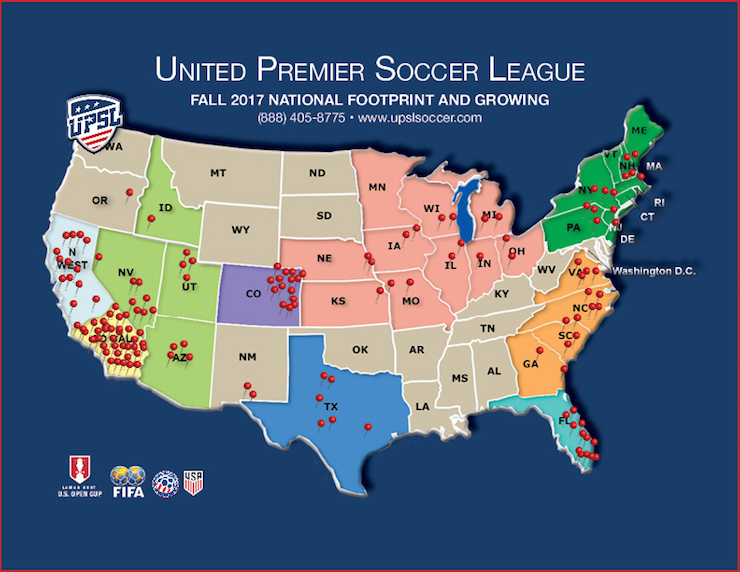UPSL’s Commissioner Yan Skwara on Soccer in America
The UPSL is one of the fastest growing adult soccer leagues in America. Under the guidance of Yan Skwara, the league’s commissioner, and President Leonel Lopez, the UPSL has experienced record expansion in a highly competitive market — and it is solid growth with amateur adult soccer clubs working well together and producing talented teams and players.
The United Premier Soccer League (UPSL) is a rapidly growing amateur adult league that focuses on pro player development. The league has grown exponentially in size and scope. This time last year, the California-born UPSL was a 48-team USASA regional elite league in four states. The league had just signed a new group of Colorado team members as new entrants to the league.
As 2018 kicks off, the UPSL is now home to 200 teams across 26 states coast to coast and has applied for the United States Adult Soccer Association’s (USASA) newly proposed National Tier 1 status. In January, the league had 125 teams participating.
UPSL’s Substantial growth has been amazing.
SoccerToday’s Diane Scavuzzo interviewed the league’s commissioner Yan Skwara on the building the league, the future of soccer in America and specifically on how UPSL is making a difference.

Diane Scavuzzo: First of all, how is the UPSL? Your league has grown dramatically.
Yan Skwara: Yes, thanks! 2017 was an amazing year — both on and off the field. Our growth exceeded well over 250% in both new teams as well as corporate sponsorship and partnerships. And, we are continuing to grow at a dramatic rate.
As you know, Promotion-Relegation is the backbone of our vision for a league structure in this country.
I am comfortable saying that it is clear that the American soccer community wants to see the implementation of Promotion-Relegation in the American game. American soccer is inspired by our league’s Promotion/Relegation Model.
We have implemented the system in several regions across the USA already in our Western and Colorado Conferences which now have two divisions, the UPSL Pro Premier and the UPSL Championship Division.
With the continued hard work and effort of our entire UPSL staff, management team and member teams, we look forward to a powerful 2018 campaign.
Becoming a national league and playing games across four time zones will have its challenges, but with an increased staff – the league has added eight new conference managers and several service representatives – will rise to meet to increased needs of the association and its members.

Diane Scavuzzo: The UPSL calls itself a pro-development league. What does this term mean?
Yan Skwara: We are extremely excited about our future prospects as a Pro-Development league.
We have created a league platform that is producing better player-talent by having our players play essentially year-round compared with only playing 3-4 months out.
If we — as a league — can play that role in improving player development, then we have done our job. If everyone who has the power and influence to help players develop would, we can win future World Cups.
Diane Scavuzzo: What needs to change in the world of youth soccer?
Yan Skwara: We must see our youth players playing in a more competitive environment — otherwise we cannot compete with the rest of the world.
This is what the UPSL offers today, a competitive playing environment that is truly growing the game, not just a slogan — and, we do it year round as we have two playing seasons in a 12 month period with two separate Championship matches.
Related Article: Soccer in the USA: Do We Want Promotion and Relegation?

Diane Scavuzzo: What would help improve adult soccer in America?
Yan Skwara: Playing year-round is a major component of the UPSL’s model. And, allowing clubs across the country to compete in a national league in a cost-effective structure that does not break the bank.
Building clubs in the USA that survive over the long haul — this is something that needs to be more consistent.
Too many clubs are in business for 1-2-3-4-5 years and then the teams fold. This is not good for the game. It only takes away from the game as the investment is lost.
Connecting American soccer is our league slogan and no better phrase describes the importance of teams having a geographical proximity to one another — this keeps travel budgets at a manageable level which, at the end of the day, allows teams to operate at a breakeven/profit level instead of at a significant loss.
Diane Scavuzzo: What is wrong in American youth soccer?
Yan Skwara: Whenever I get asked the question — or think about what can we do to improve our youth programs, I always go back to our fundamental goal as a league and that is to provide a year-round league that can reward teams for performance.
It is also important to not reward teams that fail to perform. This is tough to say, but winning a trophy at a weekend’s tournament is just not enough at the youth level.

There is a significant disconnect between youth clubs and the adult pro-development in the amateur market. There needs to be a great improvement in connecting the youth clubs in the USA with pro-am and pro clubs.
At the UPSL, we are striving every day to make this connection real and tangible — and getting those youth players competing against higher level competition on a regular, year-round basis is the key.
Diane Scavuzzo: What changes do you recommend?
Yan Skwara: Youth players must see a more defined and supported pathway to higher levels.
Youth soccer has to be more about just winning weekend tournaments.
We, as a country, need to now focus on the infrastructure of the world’s game and the way it has been set up for decades.
We must globally create passion, creativity and work ethic with our youth players.
We are lagging behind the rest of the world. That’s the reality. This is what must change.
Our mission is connecting American soccer. This is what we do and we know connecting soccer in America will help our players perform better on the world stage.

Related Article: UPSL Starts Promotion/Relegation in American Soccer
Photo Credit: UPSL and Diane Scavuzzo
UPDATED September 6, 2018 — Origially published January 5, 2018.





